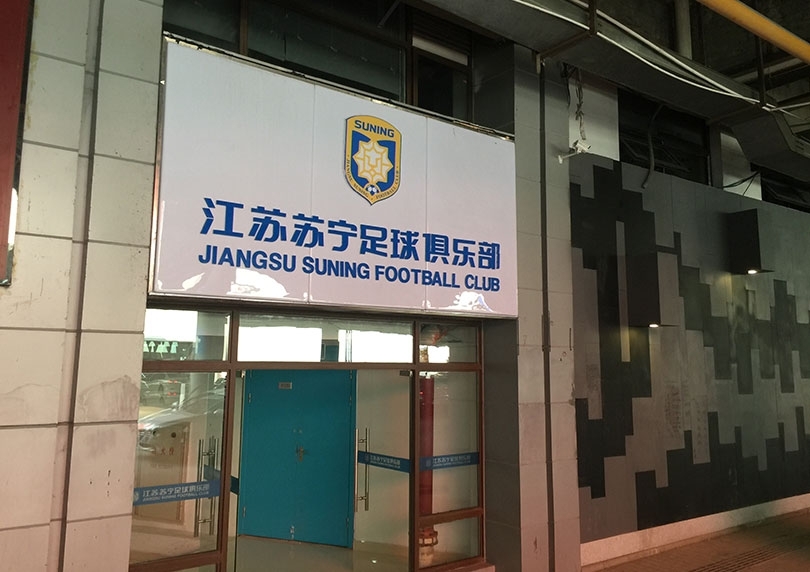Sheer pandemonium broke out in February this year when Brazilian superstar Alex Teixeira announced his arrival at Jiangsu Suning FC, the Chinese Super League (CSL) football club that has qualified this year for the Asian Football Confederation (AFC) Champions League, the pinnacle of Asian club football competitions.
The coveted up-and-comer joined with a transfer fee of €50 million, a record for Asian teams that completely outbid other rivals from around the world.
Teixeira is not the only Brazilian who has joined Jiangsu this year. Internationals Ramires, formerly of English giant Chelsea, and Joao Alves have also arrived in Nanjing with their unprecedented reputations and, of course, high salaries. Both represented the national team just as recently as at the 2014 World Cup. Big names now abound in CSL, a league that has, until recently, had a rather lame reputation.
It is not exaggerating to say that Jiangsu Suning shocked the Chinese football market, if not the wider world of professional football, during the winter transfer period this year. A local transfer expenditure record of all time, €106 million, was spent to sign eight players and promote two youngsters from the developmental squad, meaning Jiangsu has welcomed 10 new faces to the first team this season, while 10 other seniors were made to leave in order to meet the quota regulation.
Jiangsu’s €106 million transfer expenditure is almost one third of the €334 million spent by all Chinese top-tier clubs combined during the period. The total expenditure surpasses every other football league in the world. So now Jiangsu is the highest spending club in China which is the highest spending country in terms of football.
“China is the new El Dorado for football,” Brazilian football agent Marcos Motta was quoted by Indian media Mint in 2015, referring to China as the land of gold. “From the conversations I had there with club presidents, owners, president of companies and governors of the cities, they will not stop.”
There is no sign of stopping. During this year’s winter transfer window, the transfer fee record for Chinese clubs was broken four times. First came Elkeson, a Brazilian, who joined Shanghai SIPG team for €18.5 million; later, Ramires joined Jiangsu Suning for €28 million; Jackson Martinez from Colombia signed a €42 million deal with Guangzhou Evergrande; while Teixeira’s €50 million deal set the highest record. Before 2016, the record was a mere €15 million.
In fact, the trend for Chinese teams to really splash out can be traced to the turn of the decade. In 2010, the Evergrande Group, a conglomerate specialising in residential buildings, invested in the then Guangzhou FC, spending a huge amount of money purchasing local and international stars, and restructuring the whole football club. Since then, Guangzhou has made giant strides, winning five consecutive CSL titles, three domestic cup competitions, two AFC Champions League titles in the relatively short period of 6 years.
More clubs have followed suit, resulting in the CSL becoming a league filled with a staggering amount of money. Jiangsu’s massive financial injection is strongly reminiscent of what Guangzhou Evergrande FC did back in 2010.
“Investors in Jiangsu are willing to spend money, resulting in Jiangsu’s good atmosphere in football,” Cheng Tao, a football coach in Nanjing University, said in an interview. He is representing the Chinese Football Association (CFA) for a football exchange program in France this summer. This kind of opportunity used to be reserved only for top players and coaches; the interaction is growing, and connections are tightening.
Indeed, Jiangsu is following what appears to be the formula for success. A new enterprise comes in, changes the name, announces its grand plan, pours in money, and gathers instant results. Guangzhou Evergrande and Manchester City of England have proven the strategy in recent years.
Jiangsu Suning FC is slowly proving it too. Since the beginning of this season’s CSL on 4th March, Jiangsu is the only team that remains undefeated, winning five games and drawing two; however, they have been eliminated from the AFC Champions League, winning two games, drawing three and losing one.
With Jiangsu’s brand new investment in football, fans would inevitably have all kinds of expectations. “For the Suning Commerce Group to spend that much money on the club, being champions this season is important,” Zhang Feng, a Jiangsu fan who has supported the club since 2012, said in an interview.
On the other hand, fans also have reservations.
“Given all the money spent on foreign players, I hope the club would not operate at the expense of domestic players because they’re very talented too. Good performances and also a good position in the league table would really make us satisfied,” said Zhang.
Much like Zhang, others are also starting to wonder whether Jiangsu Suning will become the next Chinese football superpower. However, over the years there have been some light arguments over whether Jiangsu is one of the better places for developing football.
“The cost of football development in Jiangsu is not as low as that in Guangdong due to Jiangsu’s colder weather. The grass simply doesn’t grow in winter and artificial pitches cannot protect players as well as real grass. Some parents then stop their kids from playing football,” said Cheng, the football coach who is going abroad.
Geography might prove to be an obstacle to some places, especially inland provinces, where football clubs often face a shortage of funds. In order to survive, some clubs have to seek bigger sponsorships from coastal aristocrats, or, if necessary, even move themselves to coastal areas. Actually, 14 of the 16 CSL teams are located in coastal areas.
This kind of problem is one that Jiangsu football does not have to face, as the foundation is so fundamental that more and more clubs, professional or amateur, are formed in football’s new Promised Land, offering people more opportunities to participate in China’s most anticipated sport.
On the other hand, ever since 2015 when Chinese government approved the country’s “football reform plan”, stakeholders have been working hard to achieve its intentions, which includes having 50 million people participating in the sport, with 20,000 training centers and 70,000 pitches built in the country by 2020. The plan has been improved this year, stating the ultimate goal of becoming “a first-class football superpower” that “contributes to the international football world” by 2050.
Jiangsu is doing exactly just that; building facilities, and having more people participating. Therefore, in many ways, Jiangsu football epitomizes China’s current booming development in football.
At the moment, everything seems to stand Jiangsu in good stead.
“The phenomenon of China’s football development nowadays is that every football club has to spend big and get well-known foreign players so as to enhance the league’s reputation, and then finally they can have more resources to develop local players and local structures,” said Zhang Feng, the passionate fan. “And isn’t Jiangsu Suning the team that spent the most money in the last transfer window?”











